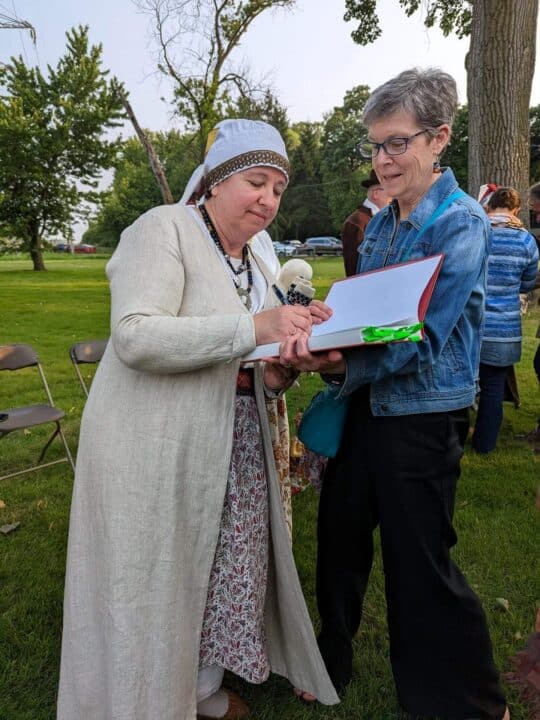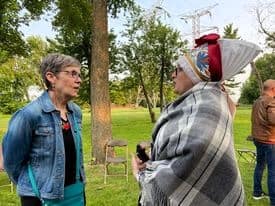By Mary Germain
I attended the “Celebrating Estonian Folk Craft and Music” event in June 2023, hosted by the Estonian Cultural Society of Chicago and the NGO Estonian Folk Art and Craft Union, and sponsored by the Estonian American National Council, Estonian Relief Committee USA and cultural organizations in Estonia.
I am a Wisconsinite with no family connection to Estonia, but I possess a strong interest in Estonia that began in 2005 through knitting. Initially, I learned about Latvian knitting when I owned a yarn shop in the 1980s and an elderly Latvian customer brought in lined Latvian mittens for me to sell on consignment. Irma was my first connection to the Baltic world.
After a knitting trip to Latvia in 2001, I learned about a Nordic Knitting Symposium which would take place in Estonia in 2005. Being right next door to Latvia with its beautiful knitting traditions, I found a lot to love in the handicraft traditions of Estonia, too. That began my love affair with Estonia! Since 2005, I have travelled to Estonia a total of eight times, always with some knitting or handicraft connection.
Although I have learned only a few polite phrases in Estonian and a few knitting terms, I am lucky to have met many Estonians who can communicate with me in English.

I would have first read about the “Airing of the folk dress” event in Estonian World when an article was published on May 3, 2023. However, that article didn’t trigger me to investigate more. I was getting ready to leave for a Handicraft Tour in southern Võro, Estonia at the end of May with Külli Jacobson of Nordic Knitters/Kagu Kudujad OÜ.
A few days after my return from the handicraft tour, I read a comment on Facebook by Anu Pink (Estonian handicraft master, author, and publisher) who mentioned she was going to America (I read the Facebook translations to get the gist of what’s being said). I asked, “Where in America?” She answered, “Chicago ja Toronto.” Another Estonian friend of mine saw the exchange and sent me a link to the Estonians in Chicago website. I read about the 2-year Zoom course that had been offered by MTÜ Rahvarõivad which “is the official certifier in Estonia of professional master crafters of folk dress.”
I wrote to the Estonian Cultural Society of Chicago to ask questions about attending as someone who does not speak Estonian. I was especially interested in the handicraft classes on Friday and was wondering if any of the events would be offered in English. Ille Sutt, one of the organizers, wrote back and assured me they were “planning to keep this event in two languages, so that everyone feels comfortable participating.” I decided to travel from Wisconsin to Illinois to attend on Friday for the handicraft classes.
On June 16, upon arrival at the address in McHenry, Illinois, I was directed across the street to the home of Sirje Press, where shoes were left at the door, and I was directed downstairs. In the lower level, students who had participated in two years of Zoom classes along with quite a few of the Estonian master craftsmen and teachers were inspecting and putting finishing touches on the folk costumes that would be worn for the graduation on Saturday. The workmanship was incredible, and it was great to be that close and get my hands on some of the items. I was quickly befriended by Anu Slorah, an outgoing Estonian living in Seattle, Washington, who had taken part in the Zoom handicraft classes. She showed me her handwoven skirt, handknit socks, and embroidered blouse. I was impressed with the beauty and craftsmanship of the folk costumes I saw. The women who participated put a lot of time and energy into the folk costumes. That goes for the Estonian handicraft teachers who also spent two years working closely (from afar) with the participants.
As much as I was looking forward to some handicraft classes that afternoon with Estonian knitting masters that I had previously either met or heard of, such as Anu Pink and Anu Randmaa, I was also delighted to meet some masters whose names and faces were new to me, especially in the embroidery and weaving crafts. Short classes gave me a little taste of Mulgi-style archaic embroidery with Kadi Vingisaar, tablet weaving with Maret Lehis, and fabric party tassels with Anu Pink. Teachers who weren’t quite as comfortable with English still got the teaching message across to me either by demonstration or with the assistance of other teachers or participants nearby. I enjoyed my handicraft classes and the demonstrations showing how to produce lucet cord using knitting needles, crochet hooks, or a lucet fork.
An outdoor dinner came next, and the Estonian masters got ready for the open-air evening program titled “No Ordinary Attire: Customs and Traditions of Estonian Folk Dress
.” (More information about this will become available on www.estoniansinchicago.com and www.estosite.org at a later date.) The program showed the various stages of dress and traditional folk costume through the family life cycle, as one grew from baby to child to young adult to married adult and finally burial. Before the program began, the audience was asked whether everyone spoke Estonian or if some did not. I believe I was the only one who raised her hand and indicated that I would need translation. My new friend, Anu Slorah, volunteered to translate for me so I had a private, immediate translation being piped quietly but directly into my ear.
After the program, I was thrilled to be introduced to Anu Pink, who signed my copy of the book “Estonian Knitting 2: Socks and Stockings” with a personal message in Estonian, which says, “Knitting is enjoyable!” Indeed, she’s absolutely right about that! I was also introduced to another admired figure, Anu Randmaa, whose fine “Roosimine. Handknitted gloves” I have so admired.

In the evening, others stayed and listened longer to the Kaidi Soosaare concert, but after a few songs I had to get on the road for my drive back to Wisconsin.
I missed seeing the twelve participants in their folk costumes during the graduation ceremony on Saturday, but I kept my eye on Facebook and Instagram to see my new friends and acquaintances in folk costume wandering downtown Chicago on Sunday. Sandra Urvak, the official photographer, captured the participants and masters in many wonderful and contrasting settings. Some of my favorites showed people in folk costumes with skyscrapers in the background or the Millennium Park “Bean” nearby.
There will certainly be more Estonian knitting and travel in my future. I’ve been a knitter and fiber instructor most of my life. As I write this, I am preparing to teach some traditional Estonian knitting techniques at Sheep and Wool Festivals in the Midwest. I also write about my knitting travels at marygtheknitter.blogspot.com. In these ways, I’ll be introducing more people to the wonderful world of Estonia!
Mary Germain is a freelance instructor based in Milwaukee, Wisconsin. She teaches specialty knitting classes and other fiber arts at various locations throughout the country.
















